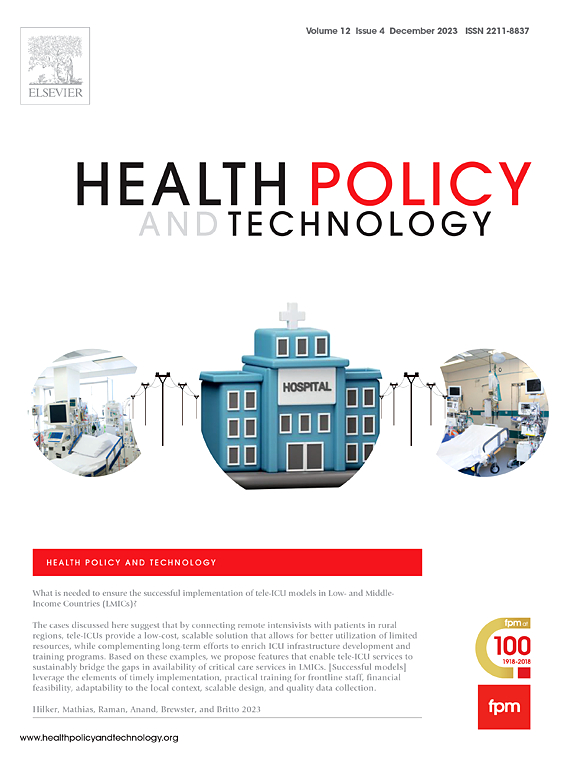Cost-utility analysis of add-on SGLT2 inhibitors for heart failure with reduced ejection fraction in India
IF 3.7
3区 医学
Q1 HEALTH POLICY & SERVICES
引用次数: 0
Abstract
Background
Heart failure with reduced ejection fraction (HFrEF) imposes significant clinical burden and costs in India. While sodium-glucose cotransporter-2 inhibitors (SGLT2i) have demonstrated clinical benefits, their cost-effectiveness within the Indian healthcare perspective remains unassessed.
Methods
A Markov model with a lifetime horizon and one-year cycles was developed to evaluate the cost-effectiveness of SGLT2i as an add-on therapy to standard of care (SoC) compared to SoC alone in patients with HFrEF in India. The analysis adopted an abridged societal perspective, incorporating direct medical and non-medical costs, as well as out-of-pocket expenditures. Clinical efficacy data were obtained from meta-analyses while cost data were sourced from published Indian studies and databases. Costs (2024) and Quality-Adjusted Life Years (QALYs) were used to determine the incremental cost-utility ratio (ICURs). A willingness-to-pay (WTP) threshold of one time India’s GDP per capita [₹2,26,765 (US$2,710)] per QALY was used. Uncertainty was assessed through one-way sensitivity analysis (OWSA) and probabilistic sensitivity analysis (PSA). Scenario analyses were conducted to test structural assumptions, and a price threshold analysis was performed to estimate the price at which SGLT2i would become cost-effective.
Results
Despite additional gains in QALYs, add-on SGLT2i were not cost-effective at their current market prices, with an ICUR of ₹6,12,406 (US$7,318) per QALY. Cost-effectiveness estimates were sensitive to variations in drug pricing. PSA confirmed the robustness of these findings. Price threshold analysis indicated that a 71 % reduction in the average market prices for SGLT2i would be required for cost-effectiveness.
Conclusions
While SGLT2i improve clinical outcomes in HFrEF, their current cost renders them not cost-effective in the Indian healthcare setting. Substantial price reductions, potentially through price negotiations with manufacturers, are necessary to enhance their affordability and optimize resource allocation for Heart failure management in India.
印度附加SGLT2抑制剂治疗心力衰竭伴射血分数降低的成本-效用分析
背景:心力衰竭伴射血分数降低(HFrEF)在印度造成了巨大的临床负担和费用。虽然钠-葡萄糖共转运蛋白-2抑制剂(SGLT2i)已显示出临床益处,但其在印度医疗保健方面的成本效益仍未得到评估。方法建立了一个具有生命周期和一年周期的马尔可夫模型,以评估SGLT2i作为标准治疗(SoC)的附加治疗与单独使用SoC在印度HFrEF患者中的成本效益。该分析采用了简略的社会观点,纳入了直接医疗和非医疗费用以及自付费用。临床疗效数据来自荟萃分析,而成本数据来自已发表的印度研究和数据库。使用成本(2024年)和质量调整寿命年(QALYs)来确定增量成本效用比(ICURs)。每个QALY的支付意愿(WTP)阈值为印度人均GDP的一倍[2,26,765卢比(2,710美元)]。通过单向敏感性分析(OWSA)和概率敏感性分析(PSA)评估不确定性。进行情景分析以检验结构假设,并进行价格阈值分析以估计sgltti具有成本效益的价格。结果尽管QALY有额外的收益,但附加的SGLT2i在目前的市场价格上并不具有成本效益,每个QALY的ICUR为6,12,406卢比(7,318美元)。成本效益估计对药品定价的变化很敏感。PSA证实了这些发现的稳健性。价格阈值分析表明,SGLT2i的平均市场价格需要降低71%才能达到成本效益。结论:虽然SGLT2i改善了HFrEF的临床结果,但其目前的成本使其在印度医疗保健环境中不具有成本效益。在印度,有必要通过与制造商进行价格谈判来大幅降低价格,以提高他们的负担能力,并优化心力衰竭管理的资源配置。
本文章由计算机程序翻译,如有差异,请以英文原文为准。
求助全文
约1分钟内获得全文
求助全文
来源期刊

Health Policy and Technology
Medicine-Health Policy
CiteScore
9.20
自引率
3.30%
发文量
78
审稿时长
88 days
期刊介绍:
Health Policy and Technology (HPT), is the official journal of the Fellowship of Postgraduate Medicine (FPM), a cross-disciplinary journal, which focuses on past, present and future health policy and the role of technology in clinical and non-clinical national and international health environments.
HPT provides a further excellent way for the FPM to continue to make important national and international contributions to development of policy and practice within medicine and related disciplines. The aim of HPT is to publish relevant, timely and accessible articles and commentaries to support policy-makers, health professionals, health technology providers, patient groups and academia interested in health policy and technology.
Topics covered by HPT will include:
- Health technology, including drug discovery, diagnostics, medicines, devices, therapeutic delivery and eHealth systems
- Cross-national comparisons on health policy using evidence-based approaches
- National studies on health policy to determine the outcomes of technology-driven initiatives
- Cross-border eHealth including health tourism
- The digital divide in mobility, access and affordability of healthcare
- Health technology assessment (HTA) methods and tools for evaluating the effectiveness of clinical and non-clinical health technologies
- Health and eHealth indicators and benchmarks (measure/metrics) for understanding the adoption and diffusion of health technologies
- Health and eHealth models and frameworks to support policy-makers and other stakeholders in decision-making
- Stakeholder engagement with health technologies (clinical and patient/citizen buy-in)
- Regulation and health economics
 求助内容:
求助内容: 应助结果提醒方式:
应助结果提醒方式:


